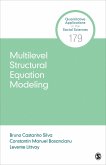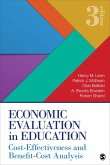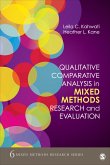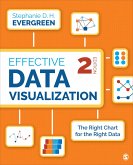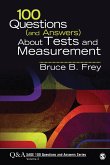- Broschiertes Buch
- Merkliste
- Auf die Merkliste
- Bewerten Bewerten
- Teilen
- Produkt teilen
- Produkterinnerung
- Produkterinnerung
Putting an emphasis on using in-depth interviews in qualitative research, this book shows readers how to expand the scope of their research
Andere Kunden interessierten sich auch für
![Qualitative Communication Research Methods Qualitative Communication Research Methods]() Thomas R. LindlofQualitative Communication Research Methods199,99 €
Thomas R. LindlofQualitative Communication Research Methods199,99 €![A Primer on Partial Least Squares Structural Equation Modeling (PLS-SEM) A Primer on Partial Least Squares Structural Equation Modeling (PLS-SEM)]() Joe HairA Primer on Partial Least Squares Structural Equation Modeling (PLS-SEM)82,99 €
Joe HairA Primer on Partial Least Squares Structural Equation Modeling (PLS-SEM)82,99 €![Multilevel Structural Equation Modeling Multilevel Structural Equation Modeling]() Bruno Castanho SilvaMultilevel Structural Equation Modeling51,99 €
Bruno Castanho SilvaMultilevel Structural Equation Modeling51,99 €![Economic Evaluation in Education Economic Evaluation in Education]() Henry M. LevinEconomic Evaluation in Education114,99 €
Henry M. LevinEconomic Evaluation in Education114,99 €![Qualitative Comparative Analysis in Mixed Methods Research and Evaluation Qualitative Comparative Analysis in Mixed Methods Research and Evaluation]() Leila KahwatiQualitative Comparative Analysis in Mixed Methods Research and Evaluation82,99 €
Leila KahwatiQualitative Comparative Analysis in Mixed Methods Research and Evaluation82,99 €![Effective Data Visualization Effective Data Visualization]() Stephanie EvergreenEffective Data Visualization104,99 €
Stephanie EvergreenEffective Data Visualization104,99 €![100 Questions (and Answers) about Tests and Measurement 100 Questions (and Answers) about Tests and Measurement]() Bruce B. Frey100 Questions (and Answers) about Tests and Measurement56,99 €
Bruce B. Frey100 Questions (and Answers) about Tests and Measurement56,99 €-
-
-
Putting an emphasis on using in-depth interviews in qualitative research, this book shows readers how to expand the scope of their research
Hinweis: Dieser Artikel kann nur an eine deutsche Lieferadresse ausgeliefert werden.
Hinweis: Dieser Artikel kann nur an eine deutsche Lieferadresse ausgeliefert werden.
Produktdetails
- Produktdetails
- Verlag: SAGE Publications Inc
- 2 Revised edition
- Seitenzahl: 320
- Erscheinungstermin: 15. Mai 2014
- Englisch
- Abmessung: 254mm x 180mm x 25mm
- Gewicht: 562g
- ISBN-13: 9781483332673
- ISBN-10: 1483332675
- Artikelnr.: 39890591
- Herstellerkennzeichnung
- Libri GmbH
- Europaallee 1
- 36244 Bad Hersfeld
- gpsr@libri.de
- Verlag: SAGE Publications Inc
- 2 Revised edition
- Seitenzahl: 320
- Erscheinungstermin: 15. Mai 2014
- Englisch
- Abmessung: 254mm x 180mm x 25mm
- Gewicht: 562g
- ISBN-13: 9781483332673
- ISBN-10: 1483332675
- Artikelnr.: 39890591
- Herstellerkennzeichnung
- Libri GmbH
- Europaallee 1
- 36244 Bad Hersfeld
- gpsr@libri.de
Dr. Janet Salmons is a qualitative scholar and methodologist. She is a Fellow at the Center for Advanced Internet Studies and edits the newsletter, "When the Field is Online". Recent books include: Doing Qualitative Research Online 2nd edition (2022), What Kind of Researcher Are You? (2021), Reframing and Rethinking Collaboration in Higher Education and Beyond: A Practical Guide for Doctoral Students and Early Career Researchers with Narelle Lemon (2021), Publishing from your Doctoral Research: Create and Use a Publication Strategy with Helen Kara (2020), Learning to Collaborate, Collaborating to Learn (2019), Find the Theory in Your Research (2019), and Getting Data Online (2019). She previously managed the Sage Research Methods Community (formerly known as Methodspace). Dr. Salmons received a B.S. in Adult and Community Education from Cornell University, an M.A. in Social Policy Studies from the SUNY Empire State College, and a Ph.D. in Interdisciplinary Studies and Educational Leadership at the Union Institute & University. She lives and works in Boulder, Colorado. Website link: www.salmons.blog
List of Figures
List of Tables
Preface
Acknowledgments
About the Author
Chapter 1: The E-Interview Research Framework
Interview Research: A Window Into the Lived Experience
Online Interview Research
Online Interviews and Multimethod Research
A Conceptual Framework for E-Interview Research
Aligning Purpose and Design
Choosing Online Data Collection Method for the Study
Taking a Position as a Researcher
Determining E-Interview or Observation Style(s)
Selecting ICT and Milieu
Using Visual Research in Online Interviews and Observations
Handling Sampling and Recruiting
Addressing Ethical Issues
Collecting the Data
Closing Thoughts
Chapter 2: Aligning Purpose and Design
Research: New Knowledge and Understandings
Understanding the "Research Interview"
What Is an In-Depth Research Interview?
Interviews in an Interview Society
Research Epistemologies, Methodologies, and Methods
Theories and Research Design
Epistemologies Influence Design Choices
Mixed Methods, Multimethods, and Mixed Epistemologies
Methodologies and Methods: Key Principles and Distinctions
Interviews and Observations in Qualitative and Mixed-Methods Studies
Closing Thoughts
Researcher's Notebook
The E-Interview Research Framework: Creating a Coherent Design
Aligning Purpose and Design Across Qualitative Methodologies
Key Concepts
Discussions and Assignments
On the Web
Chapter 3: Choosing Online Data Collection Method and Taking a Position as
a Researcher
Choosing to Collect Data with ICTs Based on Medium, Setting, or Phenomenon
Taking a Position as a Researcher
Insider (Emic) or Outsider (Etic) E-Research Positions
Rethinking Research Metaphors: Travelers, Gardeners, or Miners?
Positions, Power, and Symmetry in Interviews
Reflexivity and the Researcher's Position
Closing Thoughts
Researcher's Notebook
The E-Interview Research Framework: Choosing E-Interviews and Positions
Stories of Online Inquiry
Key Concepts
Discussions and Assignments
On the Web
Chapter 4: Determining E-Interview or Observation Styles
Structure and the Online Interview
Typology of E-Interview Structures
Structured Interviews
Semistructured Interviews
Unstructured Interviews
Life Story or Oral History Interviews
Postmodern Interviews
Co-Constructed Narratives
Creative Interviews
Structure and Technology
Structured Interviews
Semistructured Interviews
Unstructured Interviews
Motivations for Online Interviews and the Typology of E-Interview
Structures
The Researcher's Position and the Typology of E-Interview Structures
Interviews in Qualitative, Mixed-Methods, and Multimethod Studies
Closing Thoughts
Researcher's Notebook
The E-Interview Research Framework: Determining Styles for Online
Interviews
Stories of Online Inquiry
Key Concepts
Discussions and Assignments
On the Web
Chapter 5: Selecting Information and Communication Technologies and
Research Setting Milieu
Technology Equals Change
Forces for Change
The Internet: The Medium Warms
Technology Convergence: "Technologies Are Crashing Together"
Interactivity and Collaboration
Communication Richness
Nonverbal Communications and Online Interviews
Synchronous, Near-Synchronous, and Asynchronous Communication
Tools and Features for Online Interview Research
Aligning Features With Research Purposes
Choosing, Finding, or Creating a Conducive Meeting Space
Closing Thoughts
Researcher's Notebook
The E-Interview Research Framework: Selecting ICTs and Milieu
Stories of Online Inquiry
Key Concepts
Discussions and Assignments
On the Web
Chapter 6: Visual Research and the Online Qualitative Interview
Seeing the Interview: Visual Questions, Visual Answers
Multimodal Communication in a Multilingual World
Visual Literacy and Spatial Intelligence
Typology of Online Visual Interview Methods
Visual Methods in Online Interviews
Text-Based Interviews
Video Conference, Video Call, or Video Chat
Multichannel Web Conference Meeting Spaces
Immersive Virtual Environments
Using Visual Methods to Enrich Online Interview Data
Issues in Online Visual Research
Perceptual Issues
Ethical Issues
Closing Thoughts
Researcher's Notebook
Stories of Online Inquiry
Structured Visual Online Interviews
Semistructured and Unstructured Visual Online Interviews
Key Concepts
Discussions and Assignments
On the Web
Chapter 7: Handling Sampling and Recruiting: Selecting Participants for
Online Interviews
A Critical Decision: Whom to Interview?
Sampling in Qualitative Research
Types of Sampling
Size of Sample
Sample Frames
Sampling and Recruiting for Online Interview Research
Design Decisions Influence Sampling and Recruiting
Sampling Approaches Appropriate for Online Interview Research
Communicating With Potential Participants
Ensuring That Participants Are Credible
Participants Are Nominated by Trustworthy Third Party
Participants Are Pulled From Existing Sample Frames
Ensuring Research Participants That Researchers Are Credible
Getting Out the Recruitment Message
Closing Thoughts
Researcher's Notebook
The E-Interview Research Framework: Handling Sampling and Recruiting
Stories of Online Inquiry
Key Concepts
Discussions and Assignments
On the Web
Chapter 8: Addressing Ethical Issues in Online Interview Research
Ethical Research Design and Online Interviews
Ethical Research Design Fundamentals
Informed Consent
Informed Consent and Online Research
Informed Consent in Online Interview Research
Informed Consent in Online Observation Research
Identity and Privacy
Withdrawal From the Online Study
Protection of Data
Ethical Frameworks
The Deontological Approach
The Consequentialist or Utilitarian Approach
The Virtue Ethics Approach
Toward an Understanding of Internet Research Ethics
Research Design, Ethics, and Review Boards
Risk/Benefit Analysis
Review Issues for Informed Consent
Review Issues for Privacy and Confidentiality
Closing Thoughts
Researcher's Notebook
The E-Interview Research Framework: Addressing Ethical Issues
Stories of Online Inquiry: Three Researchers-Ethical or Not?
Key Concepts
Discussions and Assignments
On the Web
Chapter 9: Preparing for an Online Interview
Planning to Interview
Preparing the Questions
Communications Technologies and Online Interview Preparation
Considerations for ICT Selection
Learning the ICT
Interview Preparation by ICT Type
Preparing for Any Online Interview
Preparing for a Text-Based Interview
Synchronicity and Synchronous/Near Synchronous Text-Based Interviews
Preparing for an Asynchronous Text-Based Interview
Preparing for a Video Interview
Preparing to Interview in a Web Conferencing Meeting Space
Preparing to Interview in an Immersive Virtual Environment
Getting Ready to Interview
Defining Roles
Epoche, Self-Reflection, and Preparing to Listen
Closing Thoughts
Researcher's Notebook
Stories of Online Inquiry
Key Concepts
Discussions and Assignments
On the Web
Chapter 10: Conducting the Online Interview
Interviewer and the Interview
Conducting a Research Interview
Opening the Interview
Questioning and Guiding
Closing the Interview
Post-Interview Follow-Up
Conducting a Research Interview Using Synchronous Technologies
Text-Based Interview
Video Conference Interview
Interviews in Multichannel Web Conferencing Meeting Spaces
Interviews in Immersive Virtual Environments
Closing Thoughts
Researcher's Notebook
The E-Interview Research Framework: Conducting the Study
Stories of Online Inquiry
Key Concepts
Discussions and Assignments
On the Web
Chapter 11: Contributing Quality E-Research to the Literature
Using the E-Interview Research Framework to Assess Design and Research
Quality
Aligning Purpose and Design
Coherent but Flexible Design
Choosing Online Data Collection Method for the Study
Taking a Position as a Researcher
Insider-Outsider Perspectives and Interpretations
Power Dynamics
Reflexivity
Determining E-Interview or Observation Style(s)
Selecting ICT and Milieu
Handling Sampling and Recruiting
Addressing Ethical Issues
Conducting the Interview
Closing Thoughts
Researcher's Notebook
Stories of Online Inquiry
Discussions and Assignments
Chapter 12: Online Communications and Online Interviews Trends and
Influences
Online Communications and Online Interviews
Anywhere, Anytime Communication
Online Collaboration and Social Literacies
Disintermediation and Apomediation
Privacy in Online Milieus
ICT Trends and Implications for Researchers
Closing Thoughts and Recommendations for Further Research
Discussions and Assignments
Appendix: Qualitative Data Analysis
Glossary of Terms
References
Index
List of Tables
Preface
Acknowledgments
About the Author
Chapter 1: The E-Interview Research Framework
Interview Research: A Window Into the Lived Experience
Online Interview Research
Online Interviews and Multimethod Research
A Conceptual Framework for E-Interview Research
Aligning Purpose and Design
Choosing Online Data Collection Method for the Study
Taking a Position as a Researcher
Determining E-Interview or Observation Style(s)
Selecting ICT and Milieu
Using Visual Research in Online Interviews and Observations
Handling Sampling and Recruiting
Addressing Ethical Issues
Collecting the Data
Closing Thoughts
Chapter 2: Aligning Purpose and Design
Research: New Knowledge and Understandings
Understanding the "Research Interview"
What Is an In-Depth Research Interview?
Interviews in an Interview Society
Research Epistemologies, Methodologies, and Methods
Theories and Research Design
Epistemologies Influence Design Choices
Mixed Methods, Multimethods, and Mixed Epistemologies
Methodologies and Methods: Key Principles and Distinctions
Interviews and Observations in Qualitative and Mixed-Methods Studies
Closing Thoughts
Researcher's Notebook
The E-Interview Research Framework: Creating a Coherent Design
Aligning Purpose and Design Across Qualitative Methodologies
Key Concepts
Discussions and Assignments
On the Web
Chapter 3: Choosing Online Data Collection Method and Taking a Position as
a Researcher
Choosing to Collect Data with ICTs Based on Medium, Setting, or Phenomenon
Taking a Position as a Researcher
Insider (Emic) or Outsider (Etic) E-Research Positions
Rethinking Research Metaphors: Travelers, Gardeners, or Miners?
Positions, Power, and Symmetry in Interviews
Reflexivity and the Researcher's Position
Closing Thoughts
Researcher's Notebook
The E-Interview Research Framework: Choosing E-Interviews and Positions
Stories of Online Inquiry
Key Concepts
Discussions and Assignments
On the Web
Chapter 4: Determining E-Interview or Observation Styles
Structure and the Online Interview
Typology of E-Interview Structures
Structured Interviews
Semistructured Interviews
Unstructured Interviews
Life Story or Oral History Interviews
Postmodern Interviews
Co-Constructed Narratives
Creative Interviews
Structure and Technology
Structured Interviews
Semistructured Interviews
Unstructured Interviews
Motivations for Online Interviews and the Typology of E-Interview
Structures
The Researcher's Position and the Typology of E-Interview Structures
Interviews in Qualitative, Mixed-Methods, and Multimethod Studies
Closing Thoughts
Researcher's Notebook
The E-Interview Research Framework: Determining Styles for Online
Interviews
Stories of Online Inquiry
Key Concepts
Discussions and Assignments
On the Web
Chapter 5: Selecting Information and Communication Technologies and
Research Setting Milieu
Technology Equals Change
Forces for Change
The Internet: The Medium Warms
Technology Convergence: "Technologies Are Crashing Together"
Interactivity and Collaboration
Communication Richness
Nonverbal Communications and Online Interviews
Synchronous, Near-Synchronous, and Asynchronous Communication
Tools and Features for Online Interview Research
Aligning Features With Research Purposes
Choosing, Finding, or Creating a Conducive Meeting Space
Closing Thoughts
Researcher's Notebook
The E-Interview Research Framework: Selecting ICTs and Milieu
Stories of Online Inquiry
Key Concepts
Discussions and Assignments
On the Web
Chapter 6: Visual Research and the Online Qualitative Interview
Seeing the Interview: Visual Questions, Visual Answers
Multimodal Communication in a Multilingual World
Visual Literacy and Spatial Intelligence
Typology of Online Visual Interview Methods
Visual Methods in Online Interviews
Text-Based Interviews
Video Conference, Video Call, or Video Chat
Multichannel Web Conference Meeting Spaces
Immersive Virtual Environments
Using Visual Methods to Enrich Online Interview Data
Issues in Online Visual Research
Perceptual Issues
Ethical Issues
Closing Thoughts
Researcher's Notebook
Stories of Online Inquiry
Structured Visual Online Interviews
Semistructured and Unstructured Visual Online Interviews
Key Concepts
Discussions and Assignments
On the Web
Chapter 7: Handling Sampling and Recruiting: Selecting Participants for
Online Interviews
A Critical Decision: Whom to Interview?
Sampling in Qualitative Research
Types of Sampling
Size of Sample
Sample Frames
Sampling and Recruiting for Online Interview Research
Design Decisions Influence Sampling and Recruiting
Sampling Approaches Appropriate for Online Interview Research
Communicating With Potential Participants
Ensuring That Participants Are Credible
Participants Are Nominated by Trustworthy Third Party
Participants Are Pulled From Existing Sample Frames
Ensuring Research Participants That Researchers Are Credible
Getting Out the Recruitment Message
Closing Thoughts
Researcher's Notebook
The E-Interview Research Framework: Handling Sampling and Recruiting
Stories of Online Inquiry
Key Concepts
Discussions and Assignments
On the Web
Chapter 8: Addressing Ethical Issues in Online Interview Research
Ethical Research Design and Online Interviews
Ethical Research Design Fundamentals
Informed Consent
Informed Consent and Online Research
Informed Consent in Online Interview Research
Informed Consent in Online Observation Research
Identity and Privacy
Withdrawal From the Online Study
Protection of Data
Ethical Frameworks
The Deontological Approach
The Consequentialist or Utilitarian Approach
The Virtue Ethics Approach
Toward an Understanding of Internet Research Ethics
Research Design, Ethics, and Review Boards
Risk/Benefit Analysis
Review Issues for Informed Consent
Review Issues for Privacy and Confidentiality
Closing Thoughts
Researcher's Notebook
The E-Interview Research Framework: Addressing Ethical Issues
Stories of Online Inquiry: Three Researchers-Ethical or Not?
Key Concepts
Discussions and Assignments
On the Web
Chapter 9: Preparing for an Online Interview
Planning to Interview
Preparing the Questions
Communications Technologies and Online Interview Preparation
Considerations for ICT Selection
Learning the ICT
Interview Preparation by ICT Type
Preparing for Any Online Interview
Preparing for a Text-Based Interview
Synchronicity and Synchronous/Near Synchronous Text-Based Interviews
Preparing for an Asynchronous Text-Based Interview
Preparing for a Video Interview
Preparing to Interview in a Web Conferencing Meeting Space
Preparing to Interview in an Immersive Virtual Environment
Getting Ready to Interview
Defining Roles
Epoche, Self-Reflection, and Preparing to Listen
Closing Thoughts
Researcher's Notebook
Stories of Online Inquiry
Key Concepts
Discussions and Assignments
On the Web
Chapter 10: Conducting the Online Interview
Interviewer and the Interview
Conducting a Research Interview
Opening the Interview
Questioning and Guiding
Closing the Interview
Post-Interview Follow-Up
Conducting a Research Interview Using Synchronous Technologies
Text-Based Interview
Video Conference Interview
Interviews in Multichannel Web Conferencing Meeting Spaces
Interviews in Immersive Virtual Environments
Closing Thoughts
Researcher's Notebook
The E-Interview Research Framework: Conducting the Study
Stories of Online Inquiry
Key Concepts
Discussions and Assignments
On the Web
Chapter 11: Contributing Quality E-Research to the Literature
Using the E-Interview Research Framework to Assess Design and Research
Quality
Aligning Purpose and Design
Coherent but Flexible Design
Choosing Online Data Collection Method for the Study
Taking a Position as a Researcher
Insider-Outsider Perspectives and Interpretations
Power Dynamics
Reflexivity
Determining E-Interview or Observation Style(s)
Selecting ICT and Milieu
Handling Sampling and Recruiting
Addressing Ethical Issues
Conducting the Interview
Closing Thoughts
Researcher's Notebook
Stories of Online Inquiry
Discussions and Assignments
Chapter 12: Online Communications and Online Interviews Trends and
Influences
Online Communications and Online Interviews
Anywhere, Anytime Communication
Online Collaboration and Social Literacies
Disintermediation and Apomediation
Privacy in Online Milieus
ICT Trends and Implications for Researchers
Closing Thoughts and Recommendations for Further Research
Discussions and Assignments
Appendix: Qualitative Data Analysis
Glossary of Terms
References
Index
List of Figures
List of Tables
Preface
Acknowledgments
About the Author
Chapter 1: The E-Interview Research Framework
Interview Research: A Window Into the Lived Experience
Online Interview Research
Online Interviews and Multimethod Research
A Conceptual Framework for E-Interview Research
Aligning Purpose and Design
Choosing Online Data Collection Method for the Study
Taking a Position as a Researcher
Determining E-Interview or Observation Style(s)
Selecting ICT and Milieu
Using Visual Research in Online Interviews and Observations
Handling Sampling and Recruiting
Addressing Ethical Issues
Collecting the Data
Closing Thoughts
Chapter 2: Aligning Purpose and Design
Research: New Knowledge and Understandings
Understanding the "Research Interview"
What Is an In-Depth Research Interview?
Interviews in an Interview Society
Research Epistemologies, Methodologies, and Methods
Theories and Research Design
Epistemologies Influence Design Choices
Mixed Methods, Multimethods, and Mixed Epistemologies
Methodologies and Methods: Key Principles and Distinctions
Interviews and Observations in Qualitative and Mixed-Methods Studies
Closing Thoughts
Researcher's Notebook
The E-Interview Research Framework: Creating a Coherent Design
Aligning Purpose and Design Across Qualitative Methodologies
Key Concepts
Discussions and Assignments
On the Web
Chapter 3: Choosing Online Data Collection Method and Taking a Position as
a Researcher
Choosing to Collect Data with ICTs Based on Medium, Setting, or Phenomenon
Taking a Position as a Researcher
Insider (Emic) or Outsider (Etic) E-Research Positions
Rethinking Research Metaphors: Travelers, Gardeners, or Miners?
Positions, Power, and Symmetry in Interviews
Reflexivity and the Researcher's Position
Closing Thoughts
Researcher's Notebook
The E-Interview Research Framework: Choosing E-Interviews and Positions
Stories of Online Inquiry
Key Concepts
Discussions and Assignments
On the Web
Chapter 4: Determining E-Interview or Observation Styles
Structure and the Online Interview
Typology of E-Interview Structures
Structured Interviews
Semistructured Interviews
Unstructured Interviews
Life Story or Oral History Interviews
Postmodern Interviews
Co-Constructed Narratives
Creative Interviews
Structure and Technology
Structured Interviews
Semistructured Interviews
Unstructured Interviews
Motivations for Online Interviews and the Typology of E-Interview
Structures
The Researcher's Position and the Typology of E-Interview Structures
Interviews in Qualitative, Mixed-Methods, and Multimethod Studies
Closing Thoughts
Researcher's Notebook
The E-Interview Research Framework: Determining Styles for Online
Interviews
Stories of Online Inquiry
Key Concepts
Discussions and Assignments
On the Web
Chapter 5: Selecting Information and Communication Technologies and
Research Setting Milieu
Technology Equals Change
Forces for Change
The Internet: The Medium Warms
Technology Convergence: "Technologies Are Crashing Together"
Interactivity and Collaboration
Communication Richness
Nonverbal Communications and Online Interviews
Synchronous, Near-Synchronous, and Asynchronous Communication
Tools and Features for Online Interview Research
Aligning Features With Research Purposes
Choosing, Finding, or Creating a Conducive Meeting Space
Closing Thoughts
Researcher's Notebook
The E-Interview Research Framework: Selecting ICTs and Milieu
Stories of Online Inquiry
Key Concepts
Discussions and Assignments
On the Web
Chapter 6: Visual Research and the Online Qualitative Interview
Seeing the Interview: Visual Questions, Visual Answers
Multimodal Communication in a Multilingual World
Visual Literacy and Spatial Intelligence
Typology of Online Visual Interview Methods
Visual Methods in Online Interviews
Text-Based Interviews
Video Conference, Video Call, or Video Chat
Multichannel Web Conference Meeting Spaces
Immersive Virtual Environments
Using Visual Methods to Enrich Online Interview Data
Issues in Online Visual Research
Perceptual Issues
Ethical Issues
Closing Thoughts
Researcher's Notebook
Stories of Online Inquiry
Structured Visual Online Interviews
Semistructured and Unstructured Visual Online Interviews
Key Concepts
Discussions and Assignments
On the Web
Chapter 7: Handling Sampling and Recruiting: Selecting Participants for
Online Interviews
A Critical Decision: Whom to Interview?
Sampling in Qualitative Research
Types of Sampling
Size of Sample
Sample Frames
Sampling and Recruiting for Online Interview Research
Design Decisions Influence Sampling and Recruiting
Sampling Approaches Appropriate for Online Interview Research
Communicating With Potential Participants
Ensuring That Participants Are Credible
Participants Are Nominated by Trustworthy Third Party
Participants Are Pulled From Existing Sample Frames
Ensuring Research Participants That Researchers Are Credible
Getting Out the Recruitment Message
Closing Thoughts
Researcher's Notebook
The E-Interview Research Framework: Handling Sampling and Recruiting
Stories of Online Inquiry
Key Concepts
Discussions and Assignments
On the Web
Chapter 8: Addressing Ethical Issues in Online Interview Research
Ethical Research Design and Online Interviews
Ethical Research Design Fundamentals
Informed Consent
Informed Consent and Online Research
Informed Consent in Online Interview Research
Informed Consent in Online Observation Research
Identity and Privacy
Withdrawal From the Online Study
Protection of Data
Ethical Frameworks
The Deontological Approach
The Consequentialist or Utilitarian Approach
The Virtue Ethics Approach
Toward an Understanding of Internet Research Ethics
Research Design, Ethics, and Review Boards
Risk/Benefit Analysis
Review Issues for Informed Consent
Review Issues for Privacy and Confidentiality
Closing Thoughts
Researcher's Notebook
The E-Interview Research Framework: Addressing Ethical Issues
Stories of Online Inquiry: Three Researchers-Ethical or Not?
Key Concepts
Discussions and Assignments
On the Web
Chapter 9: Preparing for an Online Interview
Planning to Interview
Preparing the Questions
Communications Technologies and Online Interview Preparation
Considerations for ICT Selection
Learning the ICT
Interview Preparation by ICT Type
Preparing for Any Online Interview
Preparing for a Text-Based Interview
Synchronicity and Synchronous/Near Synchronous Text-Based Interviews
Preparing for an Asynchronous Text-Based Interview
Preparing for a Video Interview
Preparing to Interview in a Web Conferencing Meeting Space
Preparing to Interview in an Immersive Virtual Environment
Getting Ready to Interview
Defining Roles
Epoche, Self-Reflection, and Preparing to Listen
Closing Thoughts
Researcher's Notebook
Stories of Online Inquiry
Key Concepts
Discussions and Assignments
On the Web
Chapter 10: Conducting the Online Interview
Interviewer and the Interview
Conducting a Research Interview
Opening the Interview
Questioning and Guiding
Closing the Interview
Post-Interview Follow-Up
Conducting a Research Interview Using Synchronous Technologies
Text-Based Interview
Video Conference Interview
Interviews in Multichannel Web Conferencing Meeting Spaces
Interviews in Immersive Virtual Environments
Closing Thoughts
Researcher's Notebook
The E-Interview Research Framework: Conducting the Study
Stories of Online Inquiry
Key Concepts
Discussions and Assignments
On the Web
Chapter 11: Contributing Quality E-Research to the Literature
Using the E-Interview Research Framework to Assess Design and Research
Quality
Aligning Purpose and Design
Coherent but Flexible Design
Choosing Online Data Collection Method for the Study
Taking a Position as a Researcher
Insider-Outsider Perspectives and Interpretations
Power Dynamics
Reflexivity
Determining E-Interview or Observation Style(s)
Selecting ICT and Milieu
Handling Sampling and Recruiting
Addressing Ethical Issues
Conducting the Interview
Closing Thoughts
Researcher's Notebook
Stories of Online Inquiry
Discussions and Assignments
Chapter 12: Online Communications and Online Interviews Trends and
Influences
Online Communications and Online Interviews
Anywhere, Anytime Communication
Online Collaboration and Social Literacies
Disintermediation and Apomediation
Privacy in Online Milieus
ICT Trends and Implications for Researchers
Closing Thoughts and Recommendations for Further Research
Discussions and Assignments
Appendix: Qualitative Data Analysis
Glossary of Terms
References
Index
List of Tables
Preface
Acknowledgments
About the Author
Chapter 1: The E-Interview Research Framework
Interview Research: A Window Into the Lived Experience
Online Interview Research
Online Interviews and Multimethod Research
A Conceptual Framework for E-Interview Research
Aligning Purpose and Design
Choosing Online Data Collection Method for the Study
Taking a Position as a Researcher
Determining E-Interview or Observation Style(s)
Selecting ICT and Milieu
Using Visual Research in Online Interviews and Observations
Handling Sampling and Recruiting
Addressing Ethical Issues
Collecting the Data
Closing Thoughts
Chapter 2: Aligning Purpose and Design
Research: New Knowledge and Understandings
Understanding the "Research Interview"
What Is an In-Depth Research Interview?
Interviews in an Interview Society
Research Epistemologies, Methodologies, and Methods
Theories and Research Design
Epistemologies Influence Design Choices
Mixed Methods, Multimethods, and Mixed Epistemologies
Methodologies and Methods: Key Principles and Distinctions
Interviews and Observations in Qualitative and Mixed-Methods Studies
Closing Thoughts
Researcher's Notebook
The E-Interview Research Framework: Creating a Coherent Design
Aligning Purpose and Design Across Qualitative Methodologies
Key Concepts
Discussions and Assignments
On the Web
Chapter 3: Choosing Online Data Collection Method and Taking a Position as
a Researcher
Choosing to Collect Data with ICTs Based on Medium, Setting, or Phenomenon
Taking a Position as a Researcher
Insider (Emic) or Outsider (Etic) E-Research Positions
Rethinking Research Metaphors: Travelers, Gardeners, or Miners?
Positions, Power, and Symmetry in Interviews
Reflexivity and the Researcher's Position
Closing Thoughts
Researcher's Notebook
The E-Interview Research Framework: Choosing E-Interviews and Positions
Stories of Online Inquiry
Key Concepts
Discussions and Assignments
On the Web
Chapter 4: Determining E-Interview or Observation Styles
Structure and the Online Interview
Typology of E-Interview Structures
Structured Interviews
Semistructured Interviews
Unstructured Interviews
Life Story or Oral History Interviews
Postmodern Interviews
Co-Constructed Narratives
Creative Interviews
Structure and Technology
Structured Interviews
Semistructured Interviews
Unstructured Interviews
Motivations for Online Interviews and the Typology of E-Interview
Structures
The Researcher's Position and the Typology of E-Interview Structures
Interviews in Qualitative, Mixed-Methods, and Multimethod Studies
Closing Thoughts
Researcher's Notebook
The E-Interview Research Framework: Determining Styles for Online
Interviews
Stories of Online Inquiry
Key Concepts
Discussions and Assignments
On the Web
Chapter 5: Selecting Information and Communication Technologies and
Research Setting Milieu
Technology Equals Change
Forces for Change
The Internet: The Medium Warms
Technology Convergence: "Technologies Are Crashing Together"
Interactivity and Collaboration
Communication Richness
Nonverbal Communications and Online Interviews
Synchronous, Near-Synchronous, and Asynchronous Communication
Tools and Features for Online Interview Research
Aligning Features With Research Purposes
Choosing, Finding, or Creating a Conducive Meeting Space
Closing Thoughts
Researcher's Notebook
The E-Interview Research Framework: Selecting ICTs and Milieu
Stories of Online Inquiry
Key Concepts
Discussions and Assignments
On the Web
Chapter 6: Visual Research and the Online Qualitative Interview
Seeing the Interview: Visual Questions, Visual Answers
Multimodal Communication in a Multilingual World
Visual Literacy and Spatial Intelligence
Typology of Online Visual Interview Methods
Visual Methods in Online Interviews
Text-Based Interviews
Video Conference, Video Call, or Video Chat
Multichannel Web Conference Meeting Spaces
Immersive Virtual Environments
Using Visual Methods to Enrich Online Interview Data
Issues in Online Visual Research
Perceptual Issues
Ethical Issues
Closing Thoughts
Researcher's Notebook
Stories of Online Inquiry
Structured Visual Online Interviews
Semistructured and Unstructured Visual Online Interviews
Key Concepts
Discussions and Assignments
On the Web
Chapter 7: Handling Sampling and Recruiting: Selecting Participants for
Online Interviews
A Critical Decision: Whom to Interview?
Sampling in Qualitative Research
Types of Sampling
Size of Sample
Sample Frames
Sampling and Recruiting for Online Interview Research
Design Decisions Influence Sampling and Recruiting
Sampling Approaches Appropriate for Online Interview Research
Communicating With Potential Participants
Ensuring That Participants Are Credible
Participants Are Nominated by Trustworthy Third Party
Participants Are Pulled From Existing Sample Frames
Ensuring Research Participants That Researchers Are Credible
Getting Out the Recruitment Message
Closing Thoughts
Researcher's Notebook
The E-Interview Research Framework: Handling Sampling and Recruiting
Stories of Online Inquiry
Key Concepts
Discussions and Assignments
On the Web
Chapter 8: Addressing Ethical Issues in Online Interview Research
Ethical Research Design and Online Interviews
Ethical Research Design Fundamentals
Informed Consent
Informed Consent and Online Research
Informed Consent in Online Interview Research
Informed Consent in Online Observation Research
Identity and Privacy
Withdrawal From the Online Study
Protection of Data
Ethical Frameworks
The Deontological Approach
The Consequentialist or Utilitarian Approach
The Virtue Ethics Approach
Toward an Understanding of Internet Research Ethics
Research Design, Ethics, and Review Boards
Risk/Benefit Analysis
Review Issues for Informed Consent
Review Issues for Privacy and Confidentiality
Closing Thoughts
Researcher's Notebook
The E-Interview Research Framework: Addressing Ethical Issues
Stories of Online Inquiry: Three Researchers-Ethical or Not?
Key Concepts
Discussions and Assignments
On the Web
Chapter 9: Preparing for an Online Interview
Planning to Interview
Preparing the Questions
Communications Technologies and Online Interview Preparation
Considerations for ICT Selection
Learning the ICT
Interview Preparation by ICT Type
Preparing for Any Online Interview
Preparing for a Text-Based Interview
Synchronicity and Synchronous/Near Synchronous Text-Based Interviews
Preparing for an Asynchronous Text-Based Interview
Preparing for a Video Interview
Preparing to Interview in a Web Conferencing Meeting Space
Preparing to Interview in an Immersive Virtual Environment
Getting Ready to Interview
Defining Roles
Epoche, Self-Reflection, and Preparing to Listen
Closing Thoughts
Researcher's Notebook
Stories of Online Inquiry
Key Concepts
Discussions and Assignments
On the Web
Chapter 10: Conducting the Online Interview
Interviewer and the Interview
Conducting a Research Interview
Opening the Interview
Questioning and Guiding
Closing the Interview
Post-Interview Follow-Up
Conducting a Research Interview Using Synchronous Technologies
Text-Based Interview
Video Conference Interview
Interviews in Multichannel Web Conferencing Meeting Spaces
Interviews in Immersive Virtual Environments
Closing Thoughts
Researcher's Notebook
The E-Interview Research Framework: Conducting the Study
Stories of Online Inquiry
Key Concepts
Discussions and Assignments
On the Web
Chapter 11: Contributing Quality E-Research to the Literature
Using the E-Interview Research Framework to Assess Design and Research
Quality
Aligning Purpose and Design
Coherent but Flexible Design
Choosing Online Data Collection Method for the Study
Taking a Position as a Researcher
Insider-Outsider Perspectives and Interpretations
Power Dynamics
Reflexivity
Determining E-Interview or Observation Style(s)
Selecting ICT and Milieu
Handling Sampling and Recruiting
Addressing Ethical Issues
Conducting the Interview
Closing Thoughts
Researcher's Notebook
Stories of Online Inquiry
Discussions and Assignments
Chapter 12: Online Communications and Online Interviews Trends and
Influences
Online Communications and Online Interviews
Anywhere, Anytime Communication
Online Collaboration and Social Literacies
Disintermediation and Apomediation
Privacy in Online Milieus
ICT Trends and Implications for Researchers
Closing Thoughts and Recommendations for Further Research
Discussions and Assignments
Appendix: Qualitative Data Analysis
Glossary of Terms
References
Index




